Year 4
The English curriculum is built around the three interrelated strands of language, literature and literacy. Teaching and learning programs should balance and integrate all three strands. Together, the strands focus on developing students' knowledge, understanding and skills in listening, reading, viewing, speaking, writing and creating. Learning in English builds on concepts, skills and processes developed in earlier years, and teachers will revisit and strengthen these as needed.
In Years 3 and 4, students experience learning in familiar contexts and a range of contexts that relate to study in other areas of the curriculum. They interact with peers and teachers from other classes and schools in a range of face-to-face and online/virtual environments.
Students engage with a variety of texts for enjoyment. They listen to, read, view and interpret spoken, written and multimodal texts in which the primary purpose is aesthetic, as well as texts designed to inform and persuade. These encompass traditional oral texts including Aboriginal stories, picture books, various types of print and digital texts, simple chapter books, rhyming verse, poetry, non-fiction, film, multimodal texts, dramatic performances and texts used by students as models for constructing their own work.
The range of literary texts for Foundation to Year 10 comprises Australian literature, including the oral narrative traditions of Aboriginal and Torres Strait Islander Peoples, as well as the contemporary literature of these two cultural groups, and classic and contemporary world literature, including texts from and about Asia.
Literary texts that support and extend students in Years 3 and 4 as independent readers describe complex sequences of events that extend over several pages and involve unusual happenings within a framework of familiar experiences. Informative texts include content of increasing complexity and technicality about topics of interest and topics being studied in other areas of the curriculum. These texts use complex language features, including varied sentence structures, some unfamiliar vocabulary, a significant number of high-frequency sight words and words that need to be decoded phonically, and a variety of punctuation conventions, as well as illustrations and diagrams that support and extend the printed text.
Students create a range of imaginative, informative and persuasive types of texts including narratives, procedures, performances, reports, reviews, poetry and expositions.
(source: www.australiancurriculum.edu.au)
Achievement Standard
Receptive modes (listening, reading and viewing)
By the end of Year 4, students understand that texts have different text structures depending on purpose and context. They explain how language features, images and vocabulary are used to engage the interest of audiences. They describe literal and implied meaning connecting ideas in different textsÂ
They fluently read texts that include varied sentence structures, unfamiliar vocabulary including multisyllabic words. They express preferences for particular types of texts, and respond to others' viewpoints. They listen for and share key points in discussions.
Productive modes (speaking, writing and creating)
Students use language features to create coherence and add detail to their texts. They understand how to express an opinion based on information in a text. They create texts that show understanding of how images and detail can be used to extend key ideas.
Students create structured texts to explain ideas for different audiences. They make presentations and contribute actively to class and group discussions, varying language according to context. They demonstrate understanding of grammar, select vocabulary from a range of resources and use accurate spelling and punctuation, re-reading and editing their work to improve meaning.
(source: www.australiancurriculum.edu.au)
- Plus Plan

Persuasive Devices Interactive Activity
Explore persuasive device examples with your students using this digital game perfect for your persuasive writing lessons.
- Free Plan

Paired Passage Worksheets-Mammals vs. Reptiles
Compare mammals vs. reptiles and add to your reading instruction with leveled nonfiction, compare and contrast passages, and worksheets.
- Plus Plan

Conjunctions Spinners (Coordinating Conjunctions, Subordinating Conjunctions, Correlative Conjunctions)
Bring some fun to your grammar lessons with these colourful conjunctions spinners! Students spin tp reveal a conjunction to use in their writing or oral language.
- Plus Plan

Persuasive Devices Sorting Activity
Explore persuasive devices with your students using this set of sorting cards.
- Plus Plan

Homophones Tarsia Puzzle
Challenge your students to identify and match pairs of homophones with this differentiated Tarsia puzzle, perfect for your primary school vocabulary lessons.
- Plus Plan

Find The Imposter! Interactive Suffix Game
Practice using the suffixes -s and -es to pluralize words with an exciting FInd the Imposter Interactive activity.
- Plus Plan

-Less Suffixes Worksheet
Build vocabulary skills with a suffix worksheet featuring the suffix -less.
- Plus Plan
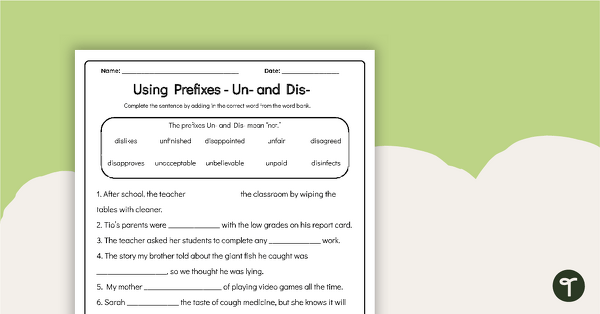
Un- and Dis- Prefixes Worksheet
Build vocabulary skills with a prefix worksheet featuring the prefixes Un- and Dis-.
- Plus Plan

Common Spelling Rules PowerPoint
Boost your students' spelling skills with an instructional slide deck teaching the different spelling rules.
- Free Plan
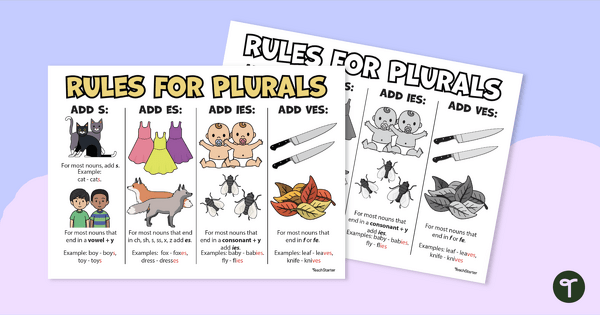
Plural Nouns Chart — Printable Plural Rules Guide
Help students remember the different plural rules with a handy printable guide created for teachers to hand out.
- Free Plan

Prefix Puzzles - Match Up Cards
Practise building, reading, and understanding the meaning of words with prefixes with a fun set of prefix puzzles.
- Free Plan

Renewable vs Non-Renewable Energy Sources – Worksheet
Discover the difference between renewable and non-renewable energy sources with a comprehension passage and worksheet.
- Plus Plan

Limericks for Kids - Poem Template
A 3-page limerick template and instructions for students to use when learning how to write a limerick.
- Plus Plan
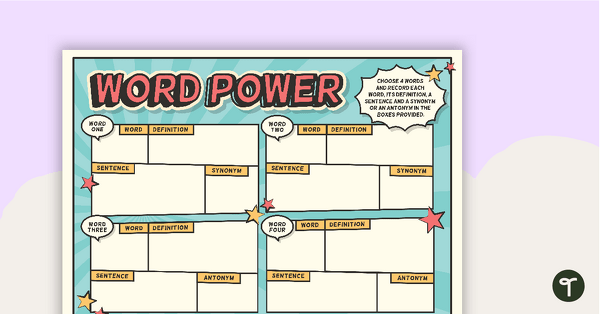
Word Power Vocabulary Worksheet
A comic book themed worksheet to use in the classroom when building vocabulary.
- Plus Plan
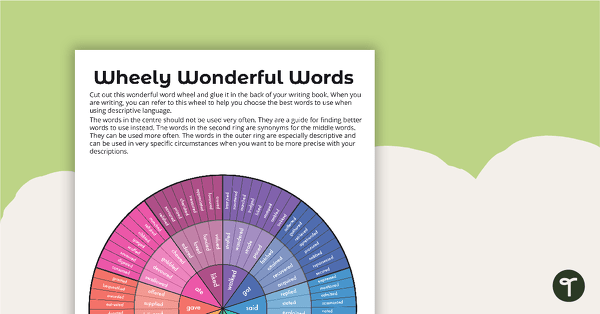
Wheely Wonderful Words – Overused Verbs
Get rid of those overused verbs with a word wheel of synonyms.
- Plus Plan

Morphology Meanings Bingo
Examine word parts and identify their morphological meanings in this BINGO game.
- Plus Plan

Imagine Conjunctions Worksheet
Spark students' creativity with this conjunctions worksheet containing four images to prompt students to write compound sentences.
- Plus Plan

Welcome to Australia! – Worksheet
A comprehension worksheet for a country profile from the Year 3 magazine (Issue 2).
- Plus Plan

Five Wonders Theme Park: Induction Booklet – Project
A project where students study the Five Wonders Theme Park stimulus poster to understand and use real world learning skills.
- Free Plan

Fact and Opinion Task Cards
A set of 12 task cards to practise identifying and writing facts and opinions.
- Plus Plan

Their, There, They're Poster
Teach students to differentiate between their, there and they're with this classroom poster.
- Plus Plan

Narrative Plot Structure Diagram
A plot diagram for students to refer to when planning their narrative writing.
- Plus Plan

Words with Prefixes Worksheet - Prefix Re-
Build students' understanding of the prefix re-.with a printable prefix worksheet.
- Free Plan

Identifying Procedural Language Worksheets
Help your students identify procedural language with this set of three worksheets.
- Plus Plan

Readers' Theatre Script - Rhyme Time
A script which can be used during readers' theatre or Drama sessions, aimed at students 8 years and over.
- Plus Plan

Write a Haiku Poem Worksheet
Set your students up for success when writing a haiku with this set of scaffolded, easy-to-follow worksheets.
- Plus Plan

Write a Cinquain Poem Worksheet
Set your students up for success when writing a cinquain poem with this set of scaffolded, easy-to-follow worksheets.
- Plus Plan

Types of Poetry Posters with Annotations
Use this set of 9 annotated posters when introducing structured forms of poetry to your students.
- Plus Plan

Comprehension Task Cards - Recognising Cause And Effect
A set of comprehension task cards to help students recognise cause and effect when reading.
- Plus Plan
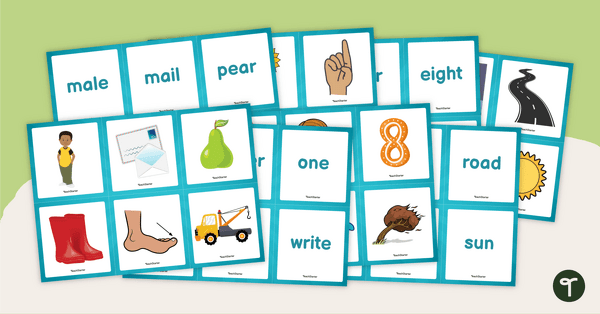
Homophones Match-Up Cards
Teach your students the meanings and spellings of some common homophones with this set of 32 match-up cards.
- Free Plan

Inference vs Prediction Poster
A poster outlining the similarities and differences between inference and prediction.
- Plus Plan

Writing Editing Checklist
Get your students using this editing checklist so that no mistake gets left behind!